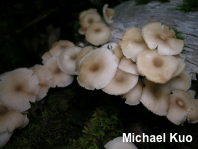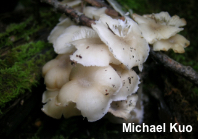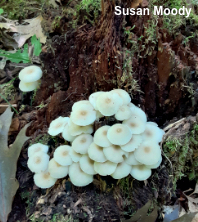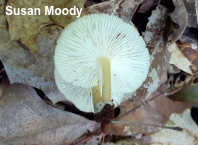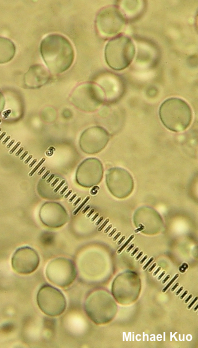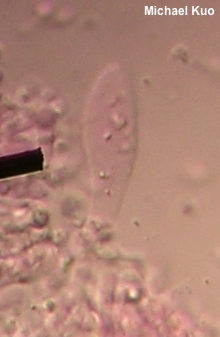| Major Groups > Gilled Mushrooms > Pale-Spored > Collybioid Mushrooms / Omphalinoid Mushrooms > Clitocybula abundans |

|
Clitocybula abundans [Basidiomycota > Agaricales > Marasmiaceae > Clitocybula...] by Michael Kuo Clitocybula abundans, as its species name suggests, frequently fruits in large numbers. Its little caps usually develop a shallow depression or "belly button" in the center, and are finely streaked with innate radial fibers. It features a white spore print, and gills that are broadly attached to the stem. It is found primarily on the wood of conifers—but it also appears on the wood of birch and other hardwoods in northern and montane areas. Similar species include Clitocybula oculus, with a slightly darker cap, a hardwoods-only habitat, and a finely scaly stem; and Clitocybula familia, with a convex cap that does not usually develop a belly button, and smaller, round spores measuring 3.5-5 µm. Clitocybula abundans is a North American species. Although the name is sometimes applied in Europe (e.g. Breitenbach & Kränzlin 1991) the mushroom described by European authors has a much darker cap and, under the microscope, features long, protruding gloeoplerous hyphae on the gill edges—misinterpreted as cheilocystidia, according to Antonin et al (2019), who argue that, on present data, "we have to consider the presence of C. abundans in Europe insufficiently proved." Thanks to Susan Moody for documenting, collecting, and preserving Clitocybula abundans for study; her collection is deposited in The Herbarium of Michael Kuo. Description: Ecology: Saprobic; growing in dense clusters on the deadwood of conifers and hardwoods (especially birch); summer and fall; originally described from New York; fairly widely distributed in northern and montane North America; also reported from Europe (perhaps erroneously; see discussion above). The illustrated and described collections are from Michigan and Minnesota. Cap: 1.5–3 cm across; convex, becoming planoconvex with a central depression or "belly button"; bald, but with innate, radiating fibers; moist when fresh; pale grayish brown centrally, grayish buff toward the margin; the margin not lined, but often splitting in age. Gills: Broadly attached to the stem or just beginning to run down it; close; short-gills frequent; white. Stem: 30–60 mm long; 2–3 mm thick; more or less equal; bald, or silky near the apex; whitish above, and a little brownish below; hollowing. Flesh: Insubstantial; watery whitish; unchanging when sliced. Odor and Taste: Not distinctive. Chemical Reactions: KOH negative on cap surface. Spore Print: White. Microscopic Details: Spores 4–7 x 3.5–5 µm; broadly ellipsoid; smooth; hyaline in KOH; weakly to moderately amyloid. Basidia 20 x 5 µm; subclavate; 4-sterigmate; tips amyloid. Pleurocystidia not found. Cheilocystidia 35–50 x 10–25 µm; clavate to irregular and oblique; smooth; thin-walled; hyaline in KOH. Pileipellis a cutis of elements 2.5–5 µm wide, smooth, hyaline in KOH, with cylindric to clavate pileocystidia in the area over the disc. Clamp connections present. REFERENCES: (Peck, 1878) Singer, 1954. (Kauffman, 1918; Breitenbach & Kränzlin, 1991; Barron, 1999; Barrasa et al., 2006; Miller & Miller, 2006; Sturgeon, 2018; Antonin et al., 2019.) Herb. Kuo 09130803, 08202003. This site contains no information about the edibility or toxicity of mushrooms. |
© MushroomExpert.Com |
|
Cite this page as: Kuo, M. (2020, December). Clitocybula abundans. Retrieved from the MushroomExpert.Com Web site: http://www.mushroomexpert.com/clitocybula_abundans.html |
